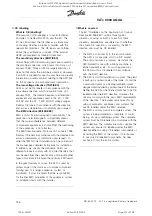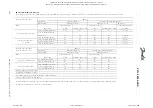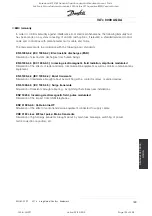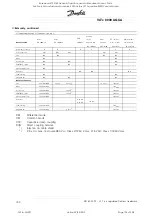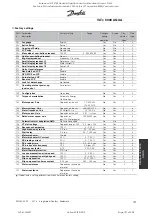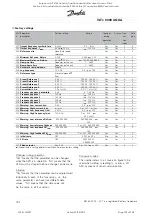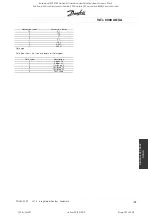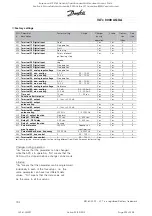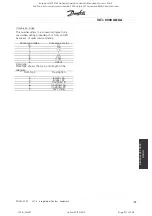
VLT
®
8000 AQUA
■
Extreme running conditions
Short circuit
VLT 8000 AQUA is protected against short circuits
by means of current measurement in each of the
three motor phases. A short circuit between two
output phases will cause an overcurrent in the
inverter. However, each transistor of the inverter
will be turned off individually when the short circuit
current exceeds the permitted value.
After 5-10 ms the driver card turns off the inverter
and the AFD will display a fault code, although
depending on impedance and motor frequency.
Ground fault
The inverter cuts out within 100 ms in case of an
ground fault on a motor phase, although depending
on impedance and motor frequency.
Switching on the output
Switching on the output between the motor and the
AFD is fully permitted. It is not possible to damage
VLT 8000 AQUA in any way by switching on the
output. However, fault messages may appear.
Motor-generated overvoltage
The voltage in the intermediate circuit is increased when
the motor acts as a generator. This occurs in two cases:
1. The load drives the motor (at constant
output frequency from the AFD), i.e. the
load generates energy.
2. During deceleration ("ramp-down") if the moment
of inertia is high, the load is low and the ramp-down
time is too short for the energy to be dissipated as a
loss in the VLT AFD, the motor and the installation.
The control unit attempts to correct the ramp
if possible. The inverter turns off to protect the
transistors and the intermediate circuit capacitors
when a certain voltage level is reached.
Line drop-out
During a line drop-out, VLT 8000 AQUA continues
until the intermediate circuit voltage drops below the
minimum stop level, which is typically 15% below
VLT 8000 AQUA
’
s lowest rated supply voltage.
The time before the inverter stops depends on the line
voltage before the drop-out and on the motor load.
Static overload
When VLT 8000 AQUA is overloaded (the current
limit in parameter 215
Current limit, I
LIM
has been
reached), the controls will reduce the output frequency
in an attempt to reduce the load.
If the overload is excessive, a current may occur that
makes the VLT AFD cut out after approx. 1.5 sec.
Operation within the current limit can be limited in time
(0- 60 s) in parameter 412
Trip delay overcurrent, I
LIM
.
■
Peak voltage on motor
When a transistor in the inverter is opened, the
voltage across the motor increases by a dU/dt
(dV/dt) ratio that depends on:
-
the motor cable (type, cross-section, length
shielded/armored or unshielded/unarmored)
-
inductance
The natural induction causes an overshot U
PEAK
in the
motor voltage before it stabilises itself at a level which
depends on the voltage in the intermediate circuit.
The rise time and the peak voltage U
PEAK
affect the
service life of the motor. If the peak voltage is too high,
motors without phase coil insulation are the ones that
will primarily be affected. If the motor cable is short (a
few feet), the rise time and peak voltage are lower.
As the length of motor cable increases, the rise time
and peak voltage at the motor terminals increases.
Because small motors are more likely to be
affected by rapid voltage changes, it is sometimes
necessary to provide proper filter between the
output of the AFD and the motor.
Data is measured using IEC 34-17.
VLT 8006 200 V, VLT 8006-8011 380-480 V
Cable
length
Line
voltage
Rise time
Peak
voltage
50 m/165 ft
380 V
0.3 µsec.
850 V
50 m/165 ft
460 V
0.4 µsec.
950 V
150 m/500 ft
380 V
1.2 µsec.
1000 V
150 m/500 ft
460 V
1.3 µsec.
1300 V
VLT 8008-8027 200-240 V, VLT 8016-8122 380-480 V
Cable
length
Line
voltage
Rise time
Peak
voltage
50 m/165 ft
380 V
0.1 µsec.
900 V
150 m/500 ft
380 V
0.2 µsec.
1000 V
MG.80.A7.22 - VLT is a registered Danfoss trademark
180
Rosewood STP ST42 General (Operation and Maintenance Manual - Part 4:
Section 6.3 Manufacturers Manuals 6.3.33 Danfoss VLT Aquadrive 8000) Vendor Manual
QP Id: VM207
Active: 03/09/2013
Page 186 of 208





















